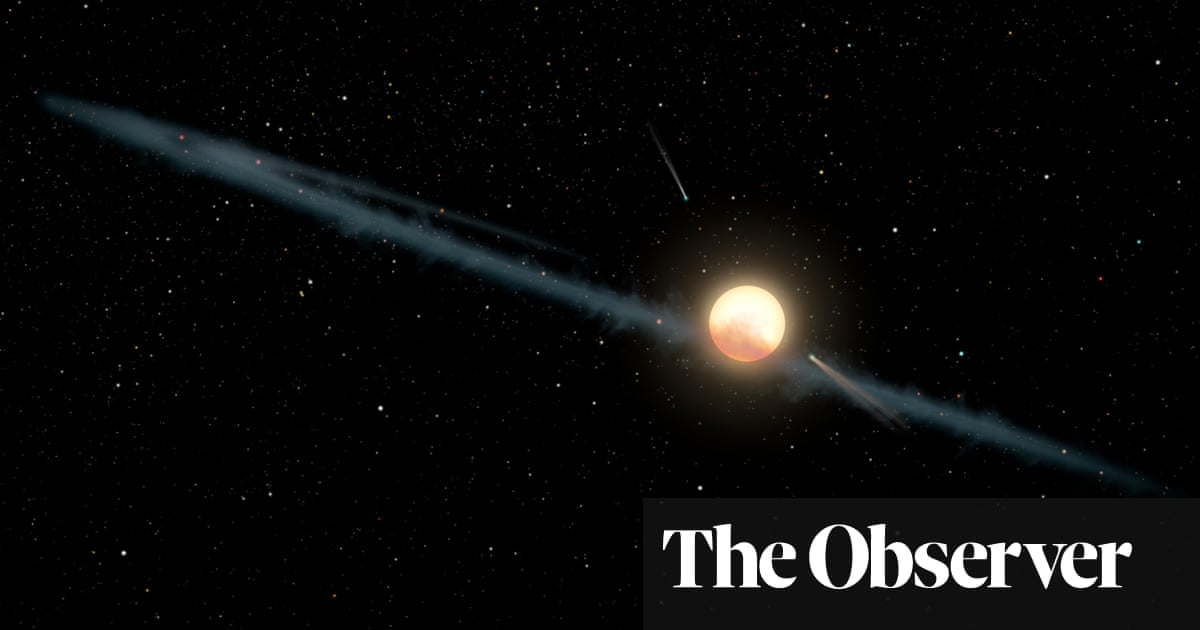It is our galaxy’s strangest star, a flickering globe of light whose sporadic and unpredictable output has baffled astronomers for years. But now the study of Boyajian’s star is being promoted as a research model that could help in one of the most intriguing of all scientific quests: finding intelligent life on other worlds.
This is the argument that Oxford University astrophysicist Prof Chris Lintott will make at a public lecture – Is it Aliens? The Most Unusual Star in the Galaxy – at a Gresham College lecture in Conway Hall, central London on Monday. His prime target will be Boyajian’s star, sometimes nicknamed Tabby’s star after scientist Tabetha Boyajian, in the constellation Cygnus whose odd dimming and brightening has been the subject of intense study by space probes and observatories in recent years.
“Its behaviour is extraordinary,” Lintott told the Observer. “It has rapid, random bursts where its brightness drops dramatically and then returns. There is no pattern to it. It flickers as if somebody was playing with its dimmer switch. There is no other star like this in our galaxy.”
Boyajian’s star was studied in detail by the Kepler space observatory in 2012 when its erratic behaviour was first uncovered. These observations indicated that a huge mass of matter circles the star in tight formation and sporadically blocks its light.
But what was the nature of this vast mass of material? Dust rings, disintegrating comets and swarms of asteroids were all put forward as explanations. However, most attention went to the theory, proposed by scientists at Penn State University, that the eclipsing mass could be a huge alien megastructure.
Such constructions were proposed by physicist Freeman Dyson, who argued that some alien civilisations might be advanced enough to build vast arrays of solar panels around their home stars to capture its heat and light. Dubbed Dyson spheres or swarms by astronomers, the great orbiting edifices would be used to power these distant civilisations.
The idea that astronomers had stumbled on such a structure triggered headlines round the globe – though not for long. Subsequent research has now undermined the idea. “We have found that light of different wavelengths is blocked in different amounts: exactly what you would expect from starlight passing through a dust cloud,” said Lintott.
Boyajian’s eclipsing mass is probably a dust cloud produced when a planet grazed too close to its surface and was torn apart. Nevertheless, the study of the strange object is important because it highlights techniques that are destined to become increasingly important as attempts to pinpoint alien civilisations intensify in coming years, Lintott argues.
Humanity could become radio-quiet in about 50 years as a result – and that will probably be true for civilisations on other worlds“The search for extraterrestrial intelligence [Seti] is changing,” he said. “We have relied in the past almost exclusively on radio telescopes to detect broadcasts from alien civilisations just as our radio and TV transmissions could reveal our presence to them. However, to date, we have heard absolutely nothing.”
Nor should we be surprised, Lintott argues. “Humanity has already passed its peak radio wave output because we are increasingly using narrow beam communications and fibre-optic cables, rather than beaming out TV and radio signals into the general environment.”
Humanity could become radio-quiet in about 50 years as a result – and that will probably be true for civilisations on other worlds, he added. “They will have gone radio silent after a while, like us. So Seti radio telescopes will need to be augmented with other ways of seeking aliens. We are going to have to be more creative about what we’re searching for in the data and find unusual things that reveal they are the handiwork of aliens.”
after newsletter promotion
Searching for Dyson spheres – huge planet-sized panels of solar arrays – will be one key route, though other ways of pinpointing the handiwork of aliens will also be needed. An example would be provided by an alien civilization that mined asteroids near their home planet, an endeavour that would create clouds of interplanetary dust that would reveal themselves from their infrared radiation.
“And while aliens may not reveal themselves through radio transmissions, they could easily betray their presence from their radar emissions that they use to guide their aircraft and spaceships,” added Lintott. “Again, we need to look at these wavelengths for signs of their existence.”
Such work will require analyses of colossal stores of data and the story of Boyajian’s star also provides a key demonstration of how they would be done. Its secrets were revealed by an army of citizen scientists, members of the public who collected and analysed the vast reams of data from the instruments that probed the star, said Lintott.
“It was their combined analyses of data about Boyajian’s that showed it was behaving in a very odd manner – and it is very likely they will be involved in fingering other weird stars in our galaxy in future projects. And you never know, the next time they might hit pay dirt.”







